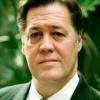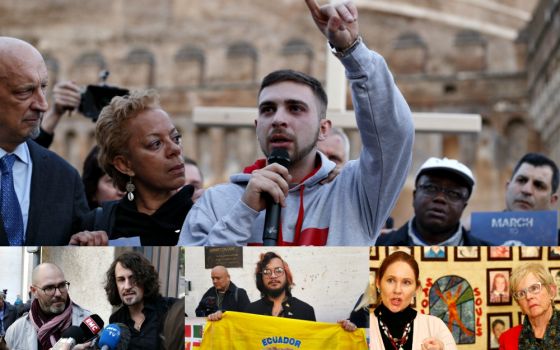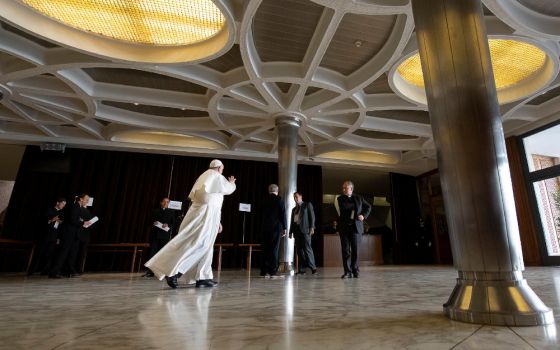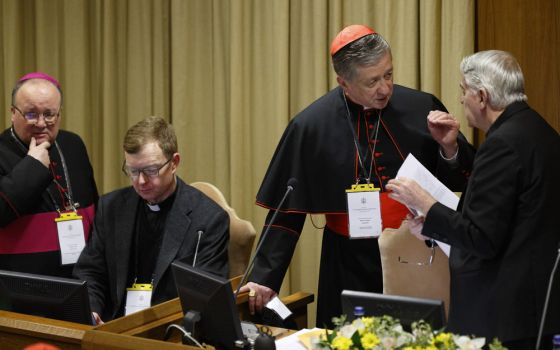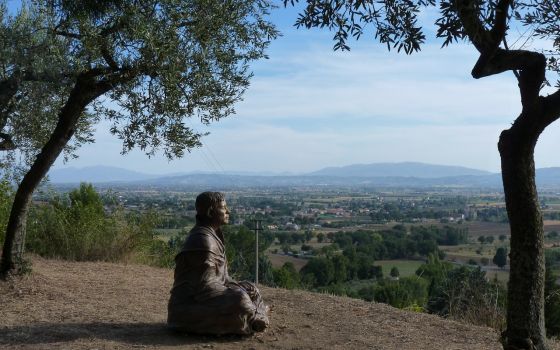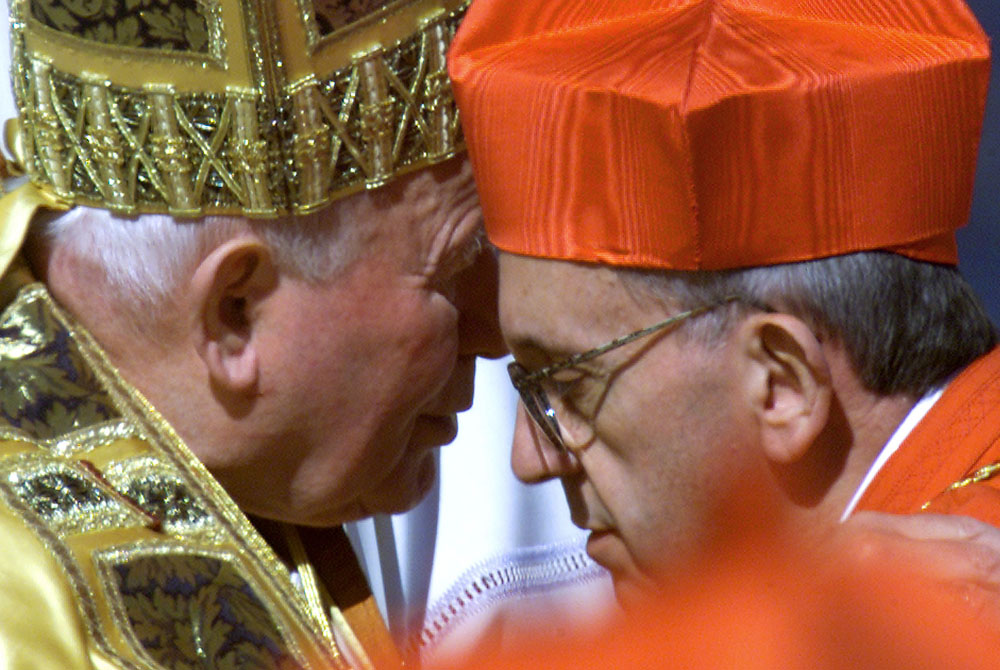
Pope John Paul II embraces Argentine Cardinal Jorge Bergoglio after presenting the new cardinal with a red beretta at the Vatican Feb. 21, 2001, setting the stage for the Bergoglio's later election as Pope Francis. (CNS/Reuters)
Editor's note: Jason Berry was the first to report on clergy sex abuse in any substantial way, beginning with a landmark 1985 report about the Louisiana case involving a priest named Gilbert Gauthe. In 1992, he published Lead Us Not into Temptation: Catholic Priests and the Sexual Abuse of Children, a nationwide investigation after seven years of reporting in various outlets. In the foreword, Fr. Andrew Greeley referred to "what may be the greatest scandal in the history of religion in America and perhaps the greatest problem Catholicism has faced since the Reformation."
Berry followed the crisis in articles, documentaries, and two other books, Vows of Silence: The Abuse of Power in the Papacy of John Paul II (2004) and Render unto Rome: The Secret Life of Money in the Catholic Church (2011), which won the Investigative Reporters and Editors Best Book Award. Given the current moment and its possibilities and the fact that Berry is singular in his experience covering the scandal from multiple angles, NCR asked if he would write a reflection on the matter as the church's bishops are about to gather in Rome to consider the issue. Below is the concluding Part 3. Read the previous entries here: Part 1 and Part 2.
The church's cover-up debacle owes greatly to John Paul II.
In 1979, barely a year after becoming pope, John Paul II visited his native Poland and stood up to the Communist regime with ringing sermons on freedom. Almost overnight, he became a force in global politics in the Cold War era. He played a catalytic role in the collapse of the Soviet empire in 1989 as the Berlin Wall cracked apart.
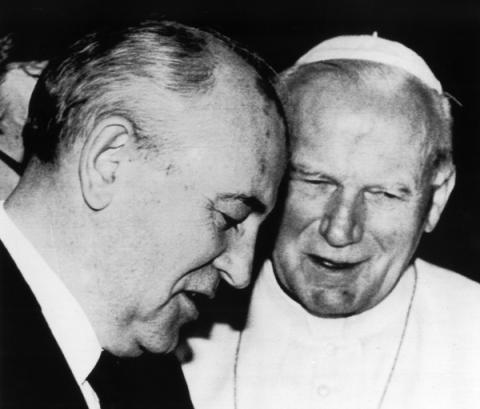
Pope John Paul II talks with Russian President Mikhail Gorbachev during a historic 1989 meeting at the Vatican. (CNS/Arturo Mari)
In November of 1989, with John Paul triumphant on the world stage, the U.S. bishops responded to a rising tide of abuse lawsuits by sending a team of canon lawyers to Rome, seeking the authority for bishops to defrock child predators. American bishops were already sending scores of offenders to church-run treatment facilities; they wanted power to the oust the worst of them. John Paul refused. For years, I wondered why.
Jonathan Kwitny's 1997 biography Man of the Century: The Life and Times of Pope John Paul II details how as cardinal of Krakow, Karol Wojtyla, backed by a unified church, was the leader of the opposition to the Communist Party. As pope, his long delays in signing papers to release priests from their vows reflected John Paul's view that a man changes ontologically on becoming a priest, his very being made new. Priests could sin but pick up and carry on. The idea of a criminal sexual underground in clerical life was beyond his ken.
What if U.S. bishops had gotten the power in 1989 to defrock sex criminals without the long delays after sending case files to various Vatican tribunals? If a few bishops had taken the lead, sacking the worst priests, the reliance on treatment tanks as de facto safe houses, or the dishonest tactics to help a Lane Fontenot or Gary Berthiaume, might have ended sooner.
Canon law allows for internal church courts to assess a priest's guilt before sending the file to Rome, requesting that he be laicized. American bishops were reluctant to use that canonical process without a speedy judgment; the files were increasingly vulnerable to subpoena by plaintiff lawyers. A priest found guilty by a secret church court would raise the financial stakes for a settlement or verdict, particularly if the bishop was waiting to hear from Rome.
I learned more about the standoff on a milky afternoon in Rome in 2002. An influential canon lawyer spoke with me on the condition that he not be identified. We sat in a spartan conference room in a building older than most American states. The Holy See was well aware of the rising lawsuit costs in 1989, he told me. "There was more concern about the scandal undermining the work of the church. In how many cases did they apply the penal procedures [ecclesial courts]? Well, none."
He leaned forward, eyes flared. "The United States has the largest tribunal system in the world. To say that people were not qualified begs the issue. The U.S. tribunals violated grandly — terribly — the annulments of marriage."
I was bewildered. "What do marriage annulments have to do with pedophiles?" I asked.
"There was a very good reason not to grant special norms on pedophiles," he declared. Divorce rates had escalated in the 1970s; the Vatican had allowed certain exceptions to facilitate annulments. "Instead, just the opposite happened … laxity on annulments," he huffed. "In America the conference of bishops had a machine signing off on [marriage] dispensations. This was highly criticized in Rome. That experience of dealing with American bishops set up a resistance to special norms for [removing] pedophiles."
As the crisis grew, Pope John Paul heard directly from bishops on their ad limina visits (every fifth-year meetings to brief the pope on a given diocese.) In 1993, Bishop Ronald Mulkearns of Ballarat, Australia, spoke of his 18-month "nightmare" over Gerald Ridsdale, a priest with scores of victims before he went to prison for many years. "There has been serious hurt inflicted on many people," Mulkearns told John Paul.
As he recounted in a pastoral letter:
I admitted to the Holy Father that the past year has been by far the worst in my experience as a bishop. … The pope was interested in and concerned about all of these issues and he reminded me of the experiences of Christ and of the stress he felt at Gethsemane and that "being in agony he prayed the longer." I felt this was no trite response, nor pious platitude, but was the successor of Peter confirming one of his brothers in the episcopate.
Then-Bishop George Pell accompanied Ridsdale to his trial. By the time Ridsdale entered prison in 1994, the Vatican had laicized him, which suggests that Mulkearns got something out of his meeting with John Paul. Any other interest John Paul had in "all of these issues" furnished Mulkearns scant guidance. In 1997, he resigned in a firestorm of criticism for recycling other predators. The past stalked Mulkearns. In February 2016, Australia's Royal Commission into Institutional Responses to Child Sexual Abuse had received accusations that he destroyed documents in Ridsdale's file and compelled Mulkearns' testimony by video-link from his nursing home. He lasted 90 minutes, apologizing, claiming he couldn't remember details. He died two months later.
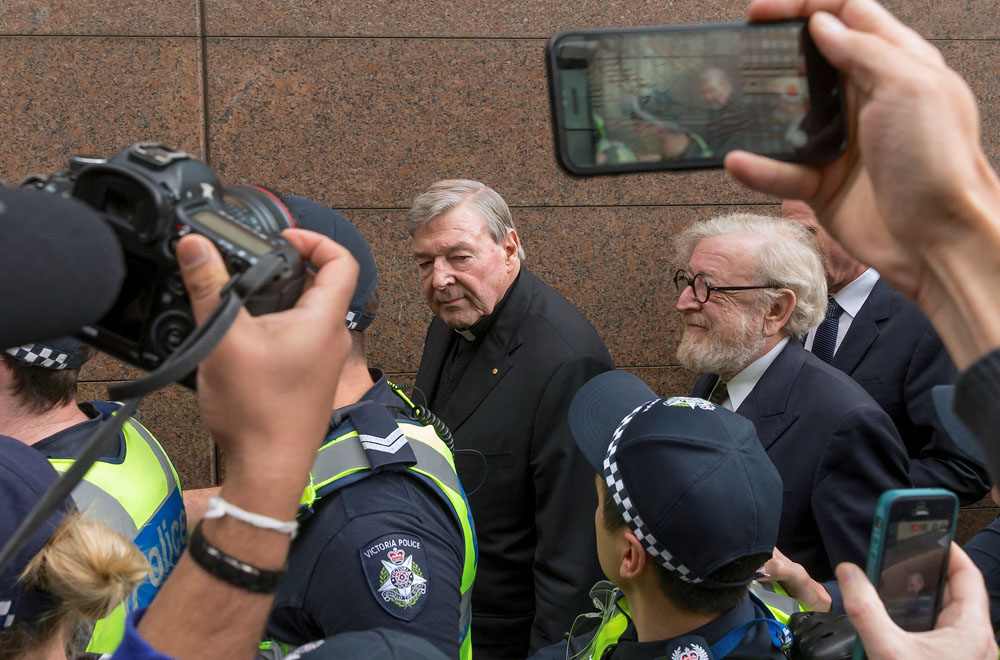
Australian Cardinal George Pell is seen after leaving the Melbourne Magistrates' Court in Australia July 26, 2017. The court set a date of Oct. 6, 2017, for the magistrate to hear evidence and decide whether there is a strong enough case to go to trial on sexual abuse charges, which the cardinal has denied. (CNS/Mark Dadswell, Reuters)
Pell became a cardinal and under Francis took an important role in Vatican finances, only to take leave in 2017, dragged back to Australia's deepening scandal. Australia has some 4,400 cases of clergy child sex abuse by 1,800 perpetrators, between 1950 and 2010 – seven percent of the nation's clergy, according to La Croix International. Pell was recently convicted of sexual abuse, though under Australia's arcane press laws, key details have been withheld. Pell sits in a cold limbo.
John Paul sank deeper into denial. In 1995, Cardinal Hans Hermann Groër of Austria, whom the pope had personally selected as a bishop (impressed by his piety at a Marian shrine), resigned as archbishop of Vienna, accused of making advances on former Benedictine seminarians. Unlike McCarrick, Groër went unpunished.
When John Paul visited Austria in 1998, Groër was a national scandal, bishops who defended him having backtracked. John Paul did not mention Groër at his public events, frustrating the upstart 500,000-member We Are Church lay group, seeking answers.
John Paul's alter-ego on the crisis was Cardinal Angelo Sodano, who after thirteen years in Chile, where he wielded a large hand in choosing bishops, became secretary of state in 1990. "The Curia is a brotherhood," Sodano once told The New York Times. Sodano, 91, now dean of the College of Cardinals, has been a peerless cover-up proponent in the brotherhood. In 2010, Austrian Cardinal Christoph Schönborn told Austrian journalists that Sodano had prevailed on John Paul to keep silent on Groër. Sodano pressured Cardinal Joseph Ratzinger not to investigate Groër.
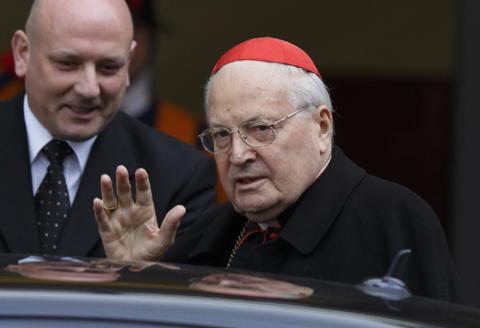
Cardinal Angelo Sodano waves towards the media March 7, 2013, as he arrives for the afternoon session of the general congregation meeting in the synod hall at the Vatican. (CNS/Paul Haring)
Sodano used more muscle after a stunning canonical case landed in 1998 at Ratzinger's Congregation for the Doctrine of the Faith tribunal. At this point, John Paul's passivity shifted to defiance. Eight former Legionaries of Christ (including a Florida diocesan priest) filed abuse charges from their years as teenage seminarians against the founder, Fr. Marcial Maciel Degollado. By then, Maciel, like some spawn of grubby Chicago or deep Louisiana politics, had sent young Legionaries with money to grease the palms of curial officials. Allegations against Maciel in Vatican offices well preceded the 1997 Hartford Courant report by Gerald Renner and this writer on eight of Maciel's victims, and the 1998 canonical case they filed.
In 1994, Cardinal Eduardo Martínez Somalo, the Spanish prefect of the congregation governing religious orders – in whose files marinated accusations against Maciel -- heard a gentle rapping on his door. A young priest dispatched by Maciel, holding an envelope with $90,000, told me years later: "I didn't bat an eye. I went up to the apartment, handed him the envelope, said goodbye." Somalo never replied to my interview request.
Nor did Sodano, a "cheerleader for the Legion," as one ex-Legionary priest told me. "He'd come give a talk at Christmas and they'd give him $10,000." Another recalled a $5,000 donation to Sodano, who refused comment in my 2012 report. Nor did NCR hear back in 2010 when questions translated into Polish went to the office in Krakow of Cardinal Stanislaw Dziwisz, which replied that he "does not have time for an interview."
As John Paul's longtime assistant, Msgr. Dziwisz received donations in envelopes, as high as $50,000 in one instance from young Legionaries, steering Maciel supporters to private papal Masses in the chapel of the Apostolic Palace. One of the priests called the funds given to Dziwisz "an elegant way of giving a bribe."
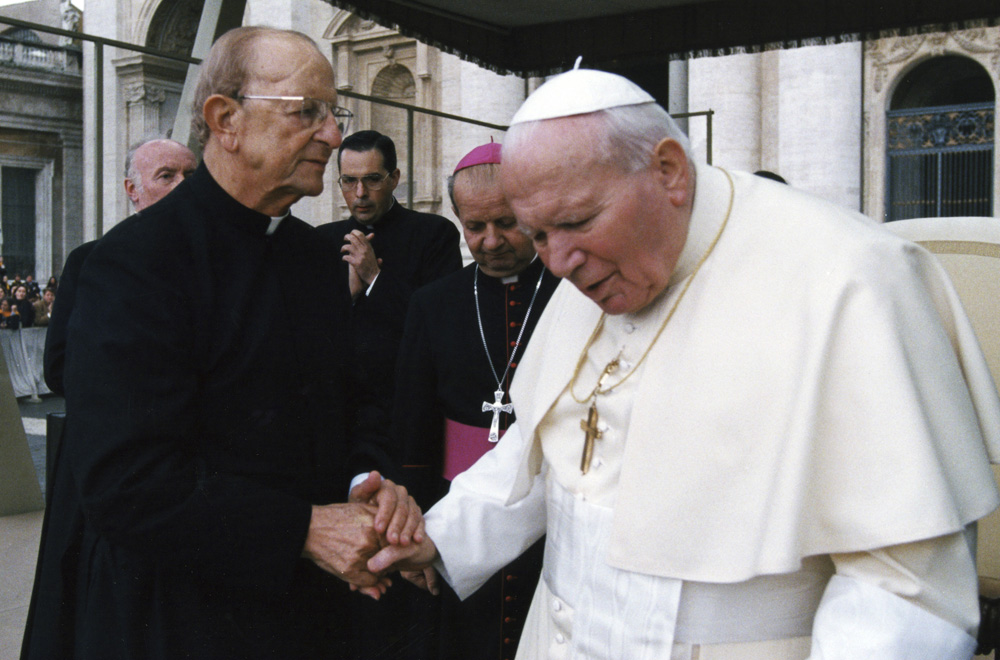
Fr. Marcial Maciel Degollado greets Pope John Paul II in St. Peter's Square in this 2000 file photo. (CNS/Catholic Press Photo)
All that money! All that goodwill hunting doled out under Maciel, the greatest fundraiser of the modern church and equally its greatest criminal. President Ronald Reagan's CIA director, William Casey, and his wife, made a seven-figure donation for construction of a Legion building in Cheshire, Connecticut, and were memorialized in a plaque.
If a single trait shapes the cover-up story line it is the reproductive cycle as one strategy of deception begets another, the scandal sprouts new faces like a Greek hydra-head, each chomping at the bit with a new lurid tale to tell.
Ratzinger, the Congregation for the Doctrine of the Faith theologian who prosecuted church intellectuals for questioning moral teaching on birth control and other issues, was a law-and-order purist. After a speech at the Legionary college, he declined the envelope with money. But he couldn't get John Paul to budge on Maciel, as Pope Francis himself cryptically revealed on the plane back from Abu Dhabi:
As for Pope Benedict, I would like to emphasize that he is a man who had the courage to do a lot of work in this area. There is an anecdote: he had all the documents regarding the congregation in which sexual and economic abuse occurred. He wanted to reach for them, but he came across obstacles and could not reach everyone. Pope John Paul II, who wanted to know the truth, asked him to meet. Joseph Ratzinger presented documentation on him, all papers he collected. When he returned, he told the secretary: "Give it to the archives, the other party won."
Who could the "other party" have been if not Sodano? Ratzinger's determination was impressive, though in the end the Vatican ended up mired in Maciel's legacy.
In 2001, Ratzinger persuaded John Paul to consolidate authority to laicize sex offenders at his tribunal, something no one else in the Curia wanted. Yet in 2002, when John Paul summoned American cardinals to Rome for an emergency conference on the crisis, Ratzinger had no answer when ABC reporter Brian Ross approached him, asking about Maciel. "Come to me when the moment is given," he snapped, slapping Ross' hand. "Not yet!"
The moment began in November 2004. Sodano arranged for a dying John Paul, his speech slurred from the neurological disorder, to celebrate Maciel's 60th anniversary as a priest at a lavish Vatican ceremony. The pope praised the long-accused pedophile for his "integral formation of the person." Ratzinger did not attend; the pope also gave the order authority over the Pontifical Institute Notre Dame of Jerusalem Center, an elegant conference and hospitality complex, and juicy plum for the religious order of fewer than 1,200 priests, but one that also had a $650 million budget and $1 billion in assets in the form of prep schools, seminaries and universities in Latin America, Europe and North America, as The Wall Street Journal reported.
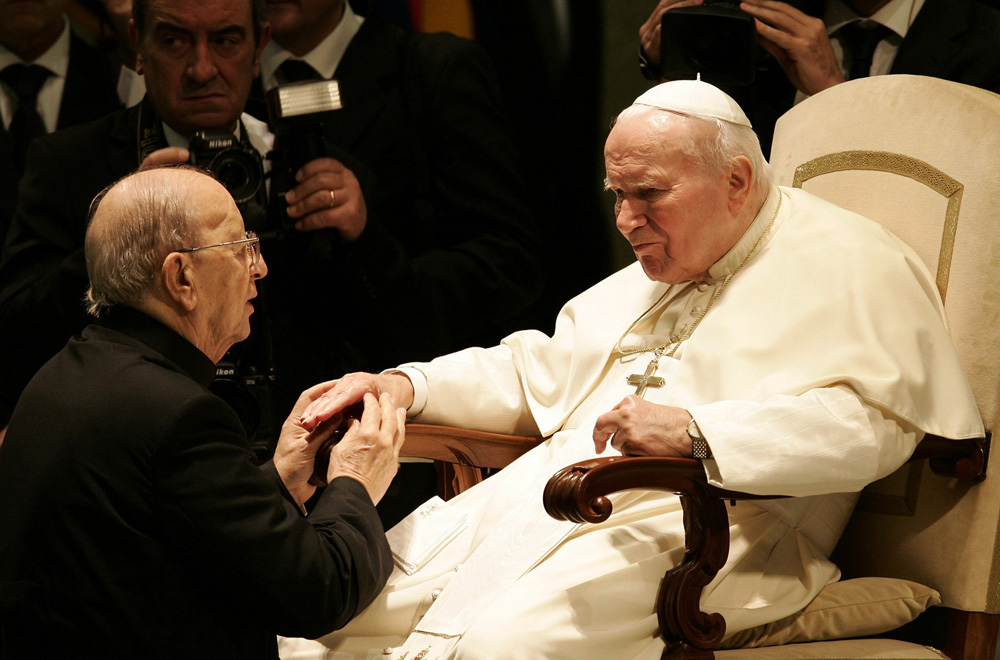
Pope John Paul II blesses Fr. Marcial Maciel Degollado, founder of the Legionaries of Christ, at the Vatican in 2004. (CNS/Tony Gentile, Reuters)
Sodano appreciated money. So did Andrea Sodano, his nephew, a structural engineer in Rome who partnered with a flashy Italian promoter, Raffaello Follieri, who set up shop in Manhattan to buy U.S. parish churches that the bishops were unloading to raise money as the abuse settlements climbed. Buy low, sell high. Secretary of State Sodano lent his presence for a 2005 company launch in the city of cities before Follieri was indicted for defrauding investors. Snug in Rome, Andrea refused a subpoena request to testify. Follieri did time in a federal penitentiary.
Sodano was Machiavellian, means justify the power; Ratzinger, a moralist, understood that with John Paul dying, whomever the cardinals chose as next pope would inherit a disaster if the Maciel case were aborted. He ordered a canon lawyer, Msgr. Charles Scicluna, to investigate.
Scicluna was taking testimony in New York when John Paul died in 2005. A few days later, Ratzinger became Pope Benedict XVI. Months later, when Scicluna delivered his fateful report — finding "more than 20 but less than 100 victims," as a background source (who if not Scicluna?) later told John L. Allen Jr., then of NCR — Pope Benedict had something else on his desk.
Awaiting the papal signature, the file by Congregation for the Causes of the Saints approved the canonization of Bishop Rafael Guízar Valencia, one of Maciel's late Mexican uncles, nominated years earlier by guess who.
How could the Vatican stage the sainthood ceremony with Maciel on display, all smiles, a living symbol of the pedophilia cover-up, displayed for a hungry news media?
On May 19, 2006, the Vatican ordered Maciel to "a life of prayer and penitence." The communiqué's language massaged by Sodano praised the Legionaries and did not acknowledge victims. (The ceremony for Guízar and three other saints came that October.)
Maciel, 86, left Rome for his native Cotija, Mexico, and a reunion with one of his former paramours and their 23-year-old daughter, whose support in Spain he had covered from Legion coffers. The Vatican had known about Maciel's offspring as early as 2005, as the retired Cardinal Franc Rodé — successor to the $90,000 Cardinal Martinez Somalo — told me in a 2012 interview. Rodé had seen a video of Maciel and his daughter from a Legionary, one of several starting to jump ship. Rodé said he told Scicluna, but did not confront Maciel because "I was not his confessor."
With Maciel gone, the Legionaries' long defense of Maciel shifted to bizarre spin control, pledging fealty to the pope, while telling followers that Maciel was wrongly accused, like Jesus, but accepted his fate with "tranquility of conscience." One can view Benedict's tolerance of the Legion's deception piled upon deception (no admission that Maciel abused anyone) as a patriarch awaiting the prodigal sons' enlightenment; or a pope getting in way over his head.
On Maciel's death in 2008, the Legion announced he was in heaven. Thirteen months later, Legion authorities announced their "discovery" that he had a daughter, shocking diehard supporters. Only then, 12 years after the pedophilia charges reported in the Hartford Courant, did the Legion finally make a public apology to victims. This was three years after Maciel's dismissal from Rome, when the order took down its website attacking Maciel's victims, Gerald Renner and me.
Soon, two men from Mexico asserted they were Maciel's sons. The Vatican, which had known about the daughter for close to four years, announced — an investigation of the Legion!
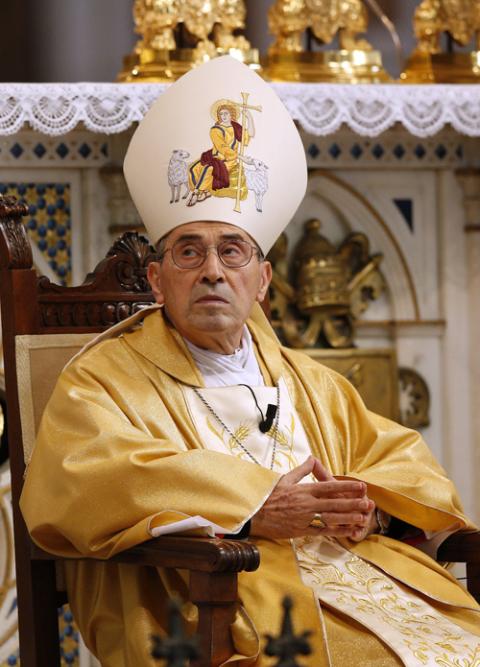
Cardinal Velasio De Paolis is seen in Rome in this 2013 file photo. The 81-year-old cardinal died Sept. 9, 2017, in Rome. (CNS/Paul Haring)
Benedict in 2010 called Maciel "out of moral bounds … a wasted, twisted life." He wanted to save the vocations of Legion priests and seminarians, who been trained in the belief that Maciel was a living saint, and warped by a cult of personality with vows never to criticize him or the superiors, and report on anyone who did — spying rewarded as faith. "Investigate" makes a great headline. Benedict appointed a Vatican canon lawyer, Cardinal Velasio De Paolis, as overseer of the order. De Paolis guided the rewriting of Legion bylaws, eliminating the secret vow, as if that would reverse generations of brainwashing. De Paolis then ordained a new crop of Legion seminarians, as many Legionaries were leaving.
In "reforming" the Legion, De Paolis failed to gain control of the order's labyrinth of finances that supported Maciel's lavish life up until his death at 87. Instead of arranging for all of the men to undergo therapy and counseling if they wished to become or remain priests, terminate the order and establish a transition for its schools and colleges to be run by dioceses or Catholic nonprofit organizations, the "renewal" under Benedict served the financial operation Maciel had fine-tuned for six decades. The founder's "wasted life" forced the Legion to sell off many millions in American real estate, close prep schools and fold a university in Sacramento amid grinding legal battles against Maciel's sons, alleged victims of other priests, and plaintiffs claiming their elderly relatives were duped into making large donations to Maciel, a living saint.
Maciel cultivated some of the wealthiest people in Latin America for support. Dionisio Garza Medina, a longtime CEO of Alfa, the business in Monterrey, Mexico, founded by his grandfather, told The Wall Street Journal in 2004: "The Legion is the only Mexican multinational in the world of religion." Take away the word "Mexican" and you have the Legion as Maciel envisioned, a multinational raising charitable funds to keep making money.
With Maciel kaput as the fundraising showpiece, the Legion shifted to a project in Israel no novelist could have invented. As the order enjoyed fawning press at the Pontifical Institute Notre Dame of Jerusalem Center, courtesy of John Paul and Sodano in 2004, they swung into action, targeting affluent believers, for a project under Fr. Juan Solano. When Pope Benedict blessed the cornerstone for a complex on the Sea of Galilee in 2009, the Legion had raised $20 million for a retreat called the "Magdala Center," according to a 2016 Smithsonian Magazine article.
In 2014, a Legion official told NCR they had raised $40 million. Forty million is a lot of dollars, added to whatever they have raised since, in one of those ho-hum financial mysteries of the church. Does the Vatican have any oversight of the Legion money machine? The plan in 2014 was for a luxury hotel. How many religious orders build hotels?
Solana, according to Ariel Sabar's 2016 Smithsonian piece, "bought four adjoining parcels of waterfront land. He'd gotten building permits for a chapel and a guesthouse with more than 100 rooms. … All that remained now was an irksome bit of red tape: a 'salvage excavation,' a routine dig by the Israeli government to ensure that no important ruins lay beneath the proposed building site."
Instead came the discovery of a first-century synagogue in the village believed to be the birth place of Mary Magdalene. Poised on its land, the Legionaries of Christ had found redemption as a religious multinational. The work of archeologists and scholars of antiquity continues. Solano writes on the Magdala website: "The construction of the Guesthouse continues, and even if we don't know yet exactly when we will be able to receive the first group, we are getting ready."
As the Legion financial machine rolls on, free at last, could Maciel, in some hot zone, be smiling?
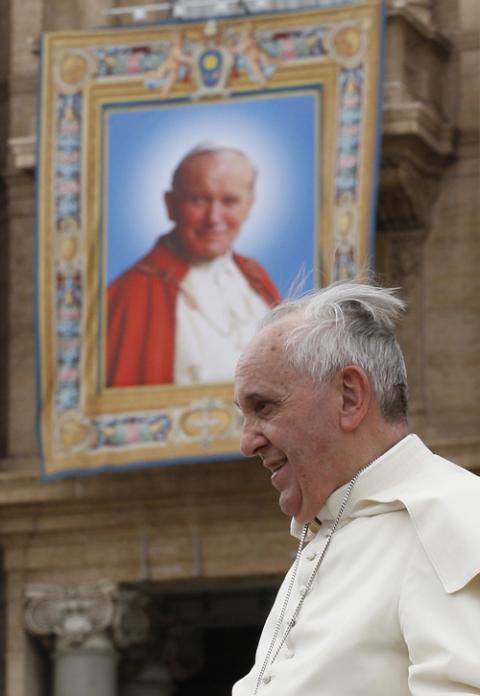
Pope Francis passes the banner of St. John Paul II as he leaves his general audience in St. Peter's Square at the Vatican April 30, 2014. (CNS/Paul Haring)
Concluding thoughts
As the episcopacy leaders gather in Rome, the releasing of perpetrators' lists (even in Mexico, where Maciel for years had Cardinal Norberto Rivera Carrera in the bag) is an encouraging sign of change.
But for a reform agenda to succeed, Francis needs a policy on the issue he has identified, in sometimes scalding rhetoric: clericalism, the pursuit of power by the clerical culture at the expense of laypeople. The calcified power structure of men covering up for men will not change itself. One way to begin that change is to install women reformers in the College of Cardinals, further breaking from Italian hierarchs, who have controlled the Roman Curia for generations. The pope has the power to elevate women as cardinals if he so chooses; John Paul offered a seat to Mother Teresa, who declined. That is a power Pope Francis should forcefully use.
The other route is to change the mandatory celibacy law. Celibacy does not cause men to abuse children any more than incest can be blamed on marriage. But the clerical culture that has lost huge numbers of men since Paul VI's 1967 encyclical praising celibacy as the church's "brilliant jewel" turned into a huge closet for gay men. Many are honorable priests who loyally serve the church; but the psychosexual maturity issues of many others, leading them to abuse teenage boys, are a key part of the crisis. Shifting the balance of power to a married clergy will take time, but ultimately drive a larger change toward a genuine, sorely needed theology of family.
Pope Francis is surrounded by a culture of men protecting men, a culture dense with sexual behavior patterns, concealing secrets and in many cases the sexual and financial crimes of this power structure. What is so desperately missing from this bizarre species of political silence is maternal grace — the wisdom of mothers who have borne and raised children — and the feminine grace of sisters and daughters, excluded by fact of gender from their rightful roles in rebuilding institutional honesty and integrity. In this regard, the ultimate cover-up act by John Paul was the 1994 declaration, Ordinatio Sacerdotalis, in which he insisted that it was Jesus's intent that only men, for the rest of human time, should be priests. The pope had no proof. Scripture does not say that Jesus "ordained" his apostles, nor that He banned women, who were vital in his public life. Sixteen months after John Paul's declaration that the church "has no authority whatsoever to confer priestly ordination on woman" he retreated into his womb of silence amid the accusations against Cardinal Groër in Vienna.
Structural changes gather support slowly, but the impact can be quite sudden, as in 1989 when the Berlin Wall cracked. For now, the leading edge of change is the information rising from broken cover-ups, and the rare willingness of a pope to acknowledge truth when he sees it. The greater question is whether Francis has the capacity to change the decaying patterns of church governance, and whether ordinary Catholics can help him do so.
[Jason Berry is the author most recently of City of a Million Dreams: A History of New Orleans at Year 300.]
Advertisement
